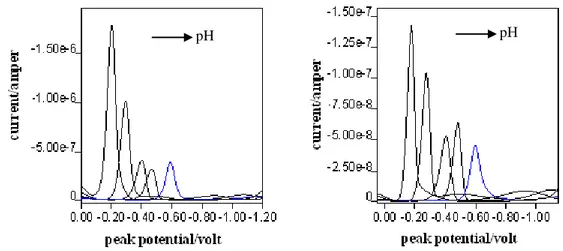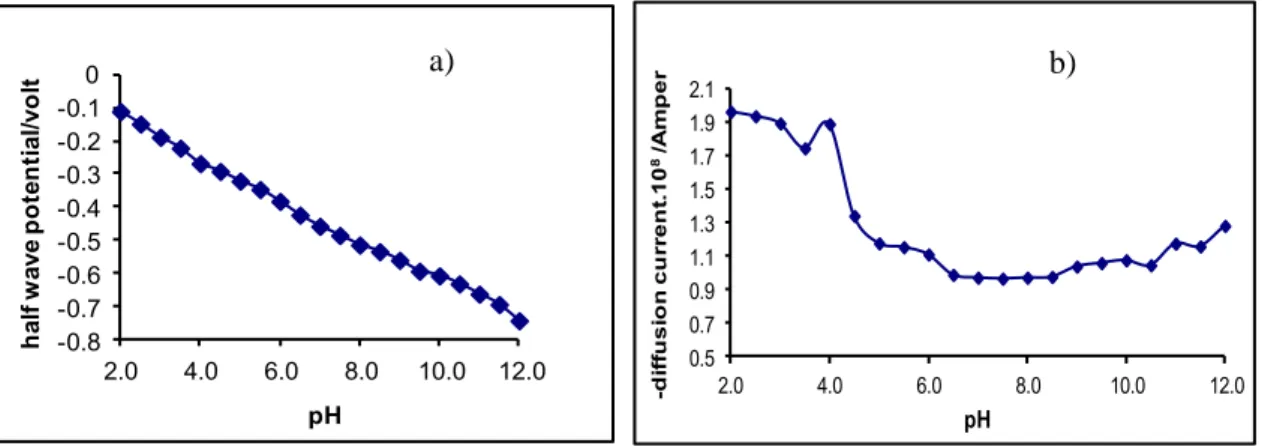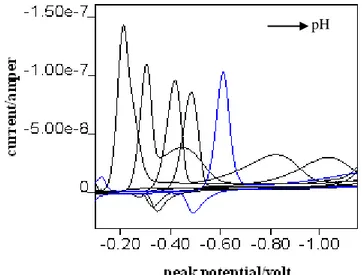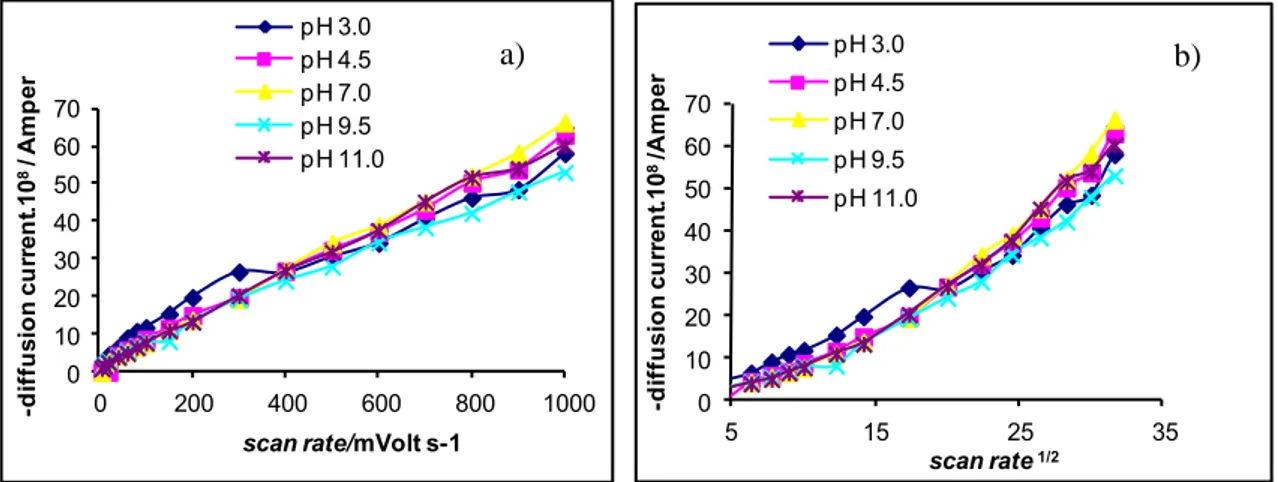Int. J. Electrochem. Sci., 8 (2013) 6399 - 6407
International Journal of
ELECTROCHEMICAL
SCIENCE
www.electrochemsci.orgInvestigation of Electrochemical Behaviour of
3-Allyl-4-Hydroxy-3'-4'- Dimethylazobenzene
Necati Menek1,*, Serpil Başaran1, Yeliz Karaman2 and Saim Topçu3
1Ondokuz Mayıs University, Sciences and Arts Faculty, Department of Chemistry, 55139
Kurupelit-SAMSUN, TURKEY
2Sinop University, Sciences and Arts Faculty, Department of Chemistry, SİNOP, TURKEY 3
Giresun University, Sciences and Arts Faculty, Department of Chemistry, GİRESUN, TURKEY
*
E-mail: nmenek@omu.edu.tr
Received: 29 January 2013 / Accepted: 31 March 2013 / Published: 1 May 2013
The reductive voltammetric and polarographic behaviour of the 3-allyl-4-hydroxy-3'-4'-dimethylazobenzene at a hanging mercury drop electrode (HMDE) and static mercury drop electrode (SMDE) has been studied in Britton-Robinson (B-R) buffers in the pH range of 2.0-12.0. The 3-allyl-4-hydroxy-3'-4'-dimethylazobenzene gave one voltammetric and polarographic peak, corresponding to the reduction of the azo group to hydrazo and amine. The reduction process was found to be dependent on the pH of the supporting electrolyte. The reduction of the azo group to amino group in acidic media and hydrazo step in neutral and basic media was observed. From the observation an electrode reaction mechanism has been suggested for the compound.
Keywords: Voltammetry, polarography, azo dyes, reduction mechanism.
1. INTRODUCTION
Aromatic azo compounds are important substances in many industrial processes aiming at, for example, the production of dyes or drugs used in chemotherapy. Since aromatic azo compounds generally are electrochemically active, much effort has been undertaken to study to redox chemistry of such compounds, mainly by polarography [1].
A number of azo dyes, which are becoming extensively scattered throughout the environment around manufacturing plants, exhibit genotoxic or ecotoxic properties leading to need for sensitive analytical methods for their determination. Modern polarographic and voltammetric methods are particularly suitable for these purposes because of their high sensitivity, their applicability over an unusually wide concentration range, and their low investment and running costs [1].
The utilization of modern polarographic and voltammetric methods in analysis for dyes and dye intermediates has been discussed in various reviews [2].
Polarography has historically been the most utilized technique for examining the reductions of aromatic azo compounds due to the properties of the DME already mentioned. There are a large number of articles published that are discussing various aspects of azo compound reduction and the interest in this topic is continuing. The aim of the majority of the investigations has been to study different aspects of the electrode processes or to find suitable compounds and conditions for analytical applications involving azo compounds.
Electrochemical behaviour of the present biologically important arylazopyrazoles was based on the dependence of the characteristic potential ie half-wave potential on electron density and other factors which in turn are simply co-related to biologically clinical, physical and chemical property and activity. As a simple relationship has been found to exist between structure. Half-wave potential and reactivity, a better understanding of the effect of structure on the redox behaviour of these compounds can be obtained [3].
The present paper describes the electrochemical behaviour of 3-allyl-4-hydroxy-3'-4'- dimethylazobenzene using differential pulse polarography (DPP), square wave voltammetry (SWV), cyclic voltammetry (CV) and direct current polarography (DCP). Our aims were to elucidate the mechanism of electrode reduction reaction. This study brings a contribution to our previous studies and other workson the electrochemistry of some azo compounds [1-14]. Molecular formula of the azo dye is given below (Scheme 1).
Scheme 1. Molecular structure of the 3-allyl-4-hydroxy-3'-4'- dimethylazobenzene.
2. EXPERIMENTAL
The synthesis, spectroscopic properties and purity of 3-allyl-4-hydroxy-3'-4'-dimethylazobenzene are reported elsewhere [15,16]. Stock solution of 1.10-3 M 3-allyl-4-hydroxy-3'-4'-dimethylazobenzene was prepared in absolute ethanol and stored in the dark bottle at room temperature. More dilute solutions were prepared daily with deionized water and absolute ethanol just before use.
A stock Britton-Robinson buffer solution was prepared which was 0.005 M in each of acetic acid (merck, 100%), phosphoric acid (merck, 85%) and boric acid (Gehalt/Assay, 99.8%) and adjusted to desired pH values with sodium hydroxide.
N=N OH
CH2CH=CH2
CH3
The polarographic and voltammetric experiments were carried out using a computer controlled electroanalysis system which is Metrohm 757 VA Computrace Electrochemical Analyser. A three electrode combination system was used. This consisted of a Multi Mode Electrode (DME, SMDE and HMDE), a Ag/AgCl reference electrode and a Pt wire auxiliary electrode. Solutions have been prepared in 30% alcohol-water (v/v) mixtures.
3. RESULTS AND DISCUSSION
The SWV and DPP voltammograms and polarograms of 3-allyl-4-hydroxy-3'-4'-dimethylazobenzene (10-5 M) in B-R buffer at different pH values were given in Figure 1. In the studied pH range of 2.0-12.0, the azo compound gives single peak. In the range of potential which is examined, peaks or waves belong to reduction of the azo group.
Figure 1. Voltammograms and polarograms of 3-allyl-4-hydroxy-3'-4'-dimethylazobenzene in Britton-Robinson Buffer solutions a) SWV (pH: 3.0, 4.5, 6.0, 7.0, 9.5 respectively), b) DPP (pH: 3.0, 4.5, 6.0, 7.0, 9.5 respectively).
The peak potential of the azo compound shifts to more negative potentials with increasing pH at all voltammetric and polarographic techniques. The change of the peak potential with pH is given in Figure 2.
As shown in Figure 2, there is a linear relationship between the Ep values as below equation;
Ep= -0.0300 – 0.060 pH (r2 =0.997) for SWV
Ep= 0.0004 – 0.064 pH (r2 =0.989) for DPP
According to these results, the shift in the peak potential values of the reduction peak to more negative potentials with increasing pH denotes that the electrode reaction is involving hydrogen ions [15,17].
Figure 2. Change in peak potential of the 3-allyl-4-hydroxy-3'-4'-dimethylazobenzene with pH in Britton-Robinson Buffer solutions a) SWV (scan rate 200 mV/s ), b) DPP (scan rate 10 mV/s, drop time 1 s) and Ag/AgCl reference electrode.
In the DCP polarograms, the change of limit currents and half wave potential values with pH are given in Figures 3 and 4 , respectively. As shown in Figures 3 and 4 limit currents decrease with increasing with pH. The observed dependence of limit current on the pH can be explained by a direct exchange of four electrons in acidic medium with splitting of the azo group to form amines while in alkaline medium only two electrons are exchanged, with reduction to the corresponding hydrazo compound. At the same time, Figure 5 supported these results.
Figure 3. Polarograms of the 3-allyl-4-hydroxy-3'-4'-dimethylazobenzene in Britton-Robinson Buffer solutions (pH:3.0, 4.5, 6.0, 7.0, 9.5 respectively) (scan rate 10 mV/s, drop time 1 s, with SMDE and Ag/AgCl reference electrode).
-0.8 -0.7 -0.6 -0.5 -0.4 -0.3 -0.2 -0.1 0 2.0 4.0 6.0 8.0 10.0 12.0 p e a k p o te n tia l/ V o lt pH b)
Figure 4. Change in a) half wave potentials b) limit currents of the 3-allyl-4-hydroxy-3'-4'-dimethylazobenzene with pH in Britton-Robinson buffer solutions (scan rate 10 mV/s, drop time 1 s for DCP and Ag/AgCl reference electrode).
Figure 5. Change in αn values of the 3-allyl-4-hydroxy-3'-4'-dimethylazobenzene with pH in Britton-Robinson buffer solutions (scan rate 10 mV/s, drop time 1 s for DCP and Ag/AgCl reference electrode).
As shown in Figures 4a and 7a, there is a linear relationship between the Ep values as below
equation;
Ep= -0.0137 – 0.061 pH (r2 =0.995) for DCP
Ep= -0.027 – 0.062 pH (r2 =0.997) for CV
Cyclic voltammograms are given in Figure 6. In neutral and basic media, anodic peak was observed but not in acidic medium. Reduction of the azo compound stops in hydrazo step. These results are supported by DPP and DCP peaks and waves.
CV voltammograms of the azo compound were recorded at scan rates of 10 and 1000 mV/s at different pH values which are shown in Figure 8. In cyclic voltammograms one well-defined cathodic peak Ic was observed at all pH and all scan rate values.
1.0 1.5 2.0 2.5 3.0 3.5 2.0 4.0 6.0 8.0 10.0 12.0 αn pH 0.5 0.7 0.9 1.1 1.3 1.5 1.7 1.9 2.1 2.0 4.0 6.0 8.0 10.0 12.0 -d if fu s io n c u rr e n t. 1 0 8/A m p e r pH -0.8 -0.7 -0.6 -0.5 -0.4 -0.3 -0.2 -0.1 0 2.0 4.0 6.0 8.0 10.0 12.0 h al f w av e p o te n ti al /v o lt pH a) b)
Figure 6. CV voltammograms of the 3-allyl-4-hydroxy-3'-4'-dimethylazobenzene in Britton-Robinson buffer solutions (pH:3.0, 4.5, 6.0, 7.0, 9.5, respectively, scan rate 100 mV/s, drop time 1 s, with HMDE and Ag/AgCl reference electrode).
Figure 7. Change in a) peak potentials and b) limit currents of the 3-allyl-4-hydroxy-3'-4'-dimethylazobenzene with pH in Britton-Robinson Buffer solutions (scan rate 10 mV/s, drop time 1 s for CV and Ag/AgCl reference electrode).
The reduction process of the azo compound is shown by peak potential shifts observed increasing with pH as shown in DPP, SWV and DCP. Oxidation peaks were observed increasing with pH. At the same time the oxidation peak currents increase with pH. Especially, small anodic peaks were observed in acidic media. At low scan rates in acidic media an irreversible oxidation wave has been seen. As the scan rate is increased the oxidation becomes quasi-reversible. This is in a good agreement in previous studies, [8-14].
In cyclic voltammograms, Ic peak current clearly shows that transfer is followed by a chemical
reaction [18]. As shown in Figure 9b, Ic peak currents change non-linearly against the square root of
scan rates. These results supported that electrode reaction mechanism is EC. Furthermore, cathodic peak currents and cathodic peak potentials approximately change linearly against the scan rate. According to this observation, adsorption step is involved in reduction process of the azo compound.
-1 -0.8 -0.6 -0.4 -0.2 0 2.0 4.0 6.0 8.0 10.0 12.0 c a th o d ic p e a k p o te n ti a l /v o l t pH a) 4.0 6.0 8.0 10.0 12.0 14.0 16.0 2.0 4.0 6.0 8.0 10.0 12.0 -d if fu s io n c u rr e n t. 1 0 8 /A m p e r pH b) pH
Figure 8. Cyclic voltammograms of different scan rates of the 3-allyl-4-hydroxy-3'-4'-dimethylazobenzene for pH a) 3.0, b) 4.5, c)7.0 and d) 9.5, scan rate: 10-1000 mV/s.
Figure 9. The change of cathodic peak currents vs. a) scan rate and b) scan rate1/2.
From polarographic and voltammetric measurements (DPP, DCP, CV and SWV) it is known that the reduction of aromatic azo compounds containing electron donating substituents, such as
0 10 20 30 40 50 60 70 0 200 400 600 800 1000 -d if fu si o n c u rr en t.1 0 8/ A m p er scan rate/mVolt s-1 pH 3.0 pH 4.5 pH 7.0 pH 9.5 pH 11.0 0 10 20 30 40 50 60 70 5 15 25 35 -d if fu si o n c u rr en t.1 0 8/A m p er scan rate1/2 pH 3.0 pH 4.5 pH 7.0 pH 9.5 pH 11.0 a) b) a) b) c) d)
hydroxy and amino groups involve a cleavage of the azo bridge to yield the corresponding amines in weak acidic solutions while the reduction of unsubstituted with electron drawing substituents generally gives to corresponding hydrazo compounds [4,5]. It is therefore reasonable to assume that the majority of the azo compound studied here is reduced to corresponding amines in acidic media. But increasing with pH, reduction of the azo compound stops in hydrazo step. The cleavage of the azo bridge should be a four electron process while a reduction to hydrazo compound should involved only two electrons. These results are appreciability supported from DPP, DCP, SWV and CV polarograms and voltammograms. According to SWV, DPP, DCP and CV techniques, the reduction mechanism can be suggested (Scheme 2). Similar results were observed in previous studies [3,5,19-24].
Scheme 2. Reaction mechanism of the 3-allyl-4-hydroxy-3'-4'- dimethylazobenzene.
ACKNOWLEDGEMENTS
The authors thank to G.Turgut, M. Odabaşoğlu for supplying the azo compound. References
1. A. Eriksson, L. Nyholm, Electrochimica Acta, 44 (1999) 4029
2. A. G. Fogg, M.V.B. Zanoni, R. Yusoff, A. R. H. M. Ahmad, J. Barek, J. Zima, Analytica Chimica Acta, 362 (1998) 235
3. R. Jain, S. Rani, R. N. Goyal, Electrochimica Acta, 26 (1981) 1519
4. F.G. Thomas, K.G. Boto,“in: The Chemistry of Hydrazo, azoxy and Azo Compounds”(S.Patai Ed.), Chichester (1975) OH CH2CH=CH2 H2N Basic Acidic 2e+2H+ 2e+2H+ 2e+2H+ CH3 CH3 NH NH OH CH2CH=CH2 CH3 CH3 NH NH OH CH2CH=CH2 OH CH2CH=CH2 N=N CH3 CH3 CH3 CH3 NH2
5. J. Strandis, V. Glezer “in:Encylopedia of the Electrochemistry of the Elements” Vol 13, (A. J. Bard, H. Lund. Ed.) Dekker, New York (1979)
6. N. Menek, S. Topcu, M. Uçar, Analytical Letters, 34 10 (2001) 1733 7. T. M. Florence, Aust. J. Chem., 18 (1965) 609
8. M. Uçar, A.O. Solak, N. Menek, Analytical Sciences, 18 (2002) 997
9. M. Uçar, M.L. Aksu, A.O. Solak, N. Menek, Bulletin of Electrochemistry, 18 5 (2002) 223
10. N. Menek, "A Polarographic and Voltammetric Behaviour of Same Azo Dyes”, Ondokuz Mayıs University, Institue of Science, PHD Thesis, February, Samsun (1994)
11. N. Menek, G. Turgut, M. Odabaşoglu, Turkish Journal of Chemistry, 23 4 (1999) 423 12. N. Menek, Analytical Letters, 31 2 (1998) 275
13. N. Menek, O. Çakır, H. Kocaokutgen, Mikrochimica Acta, 122 (1996) 203 14. N. Menek, S. Topçu, Bulletin of Electrochemistry, 19 3 (2003) 133
15. H. Zollinger, “Azo and Diazo Chemistry” Interscience Publishers New-York, London, (1961) 16. G. Turgut, "Preparation and Characterization of some phenlyazo--Naphtoxy and
phenylazo-o-allylphenoxy cyclotriphosphazenes”, Ondokuz Mayıs University, Institue of Science, PHD Thesis, Samsun (2004)
17. P. Zuman, C.L. Perin, “Organic Polarography”, John Wiley&Sons, New York (1965) 18. A. J. Bard, L.R. Faulkner, “Electrochemical Methods”, John Wiley&Sons, New York (1980) 19. N. Menek, S. Başaran, G. Turgut, M. Odabaşoğlu, Dyes and Pigments, 61, 1, (2004) 85 20. N. Menek, Y. Karaman, Bulletin of Electrochemistry, 20 9 (2004) 399
21. N. Menek, S.Topçu, M. Uçar, Analytical Letters, 34 10 (2001) 1733
22. J. Barek, H. Kvapilova, V. Mejstrik, O. Petira, and J. Zima, Collect. Czech. Chem. Commun., 55, (1990) 2636
23. S. A. Yasin, Portugaliae, 24, (2006) 23
24. B. Nigovic, S. K. Lovric, B. Simunic, Electroanalysis, 17, (2005) 839




